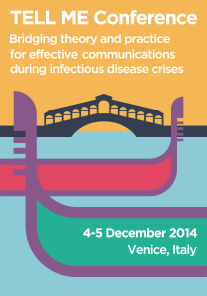D1.2 - Review of components of outbreak communication
During an epidemic, one of the major challenges has always been communicating with the population in order to influence behaviours, reduce the spread of disease and even avoid panic. Human behaviour significantly affects disease transmission and it is thus vital that we continue to improve and understand the way in which we communicate with the public.
Aim of this report is to
- consider the key components and issues of outbreak communications
- identify the issues that need to be considered by those shaping outbreak communications
- ensure that past mistakes are avoided, good practice and lessons have been learned and more successful communications is achieved.
The research focused on findings related to outbreak communications issued in response to epidemics and pandemics affecting Europe within the last 10 years, with a particular interest in the 2009 flu pandemic. Although the objective has never been to produce definitive recommendations, some lessons have been learned and good practice identified that in time will be clarified and honed into a comprehensive ‘tool set’ as an outcome from the overall TELL ME project for use in future outbreak communication situations.
Sources
The source of information in a crisis can influence the way in which communications are interpreted, perceived and accepted. The research stressed out that health care providers, particularly local and regional physicians, remain a trusted source of information, while NGOs are often considered more trustworthy than Governments.
Message
The type, tone and terminology used for communications in a crisis should be appropriate to the understanding and knowledge of their intended audience. Health authorities must communicate with empathy and understanding. It is vital that they are open and address the needs and concerns of the public.
Media
There is a wide variety of different media available for communicating with the public. The health authority should choose strategies appropriate for and reflective of the diverse audiences for which they are intended. Whilst the “classic” mass media have an enormous impact on the public’s understanding and perception of a crisis, it is also necessary to embrace modern technologies, and most notably social media, in order to ensure that messages reach those they are intended for. Social media are becoming increasingly prominent and are a powerful means of leveraging large sections of the public. When used effectively, they will assist health authorities to be more in tune with their audiences.
Timing
Early detection and decision‐making are crucial in managing an outbreak situation. Similarly, any announcements from the health authorities need to be made as early as possible. Informed and accurate communication should also continue throughout all phases of a pandemic and on a frequent basis in order to avoid speculation and false reporting. Authorities do however need to be mindful of information stress generated by repeated and unfulfilled scares.
Acceptance
Trust is one of the most significant factors related to successful crisis communications, since it will affect people’s judgements and subsequent acceptance of recommended measures. Trust needs to be built up over time and can be eroded by ineffective communications. In this regard, it is important for health authorities to be open and honest and to acknowledge uncertainty. It is also vital for health authorities to understand the needs and interests of the public. Fears and concerns need to be acknowledged however mistaken they might be.
Pandemic preparedness
When the next pandemic will strike, there will not be time to develop a crisis communication plan. This is the reason why communication plans should be prepared as early as possible, and the staff trained and exercised in their use. The crisis communication plan should be developed as a separate but supportive task of the actual crisis management plan. Within the plans, health authorities need to embrace new technology, in particular social media, and allow a two-way flow of information between officials and the public.
Read the document online:
D1.2 - Review of components of outbreak communication


